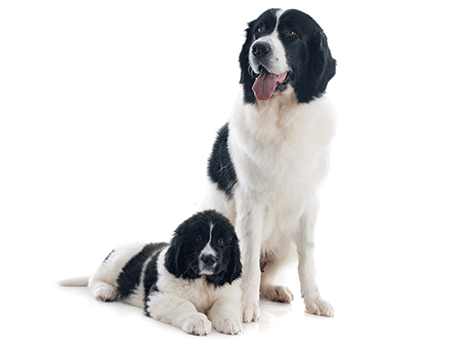Lifestage nutrition: Different needs call for different feeds
Your veterinary clients know you cant feed a human baby what you feed an adult. And yet, they may think nothing of filling their puppys bowl with kibble meant for mature dogs and vice versa. Be ready to counsel them on how nutritional needs

That these two pups shouldn't eat the same food is obvious to you, but it may not be as clear to your clients. (cynoclub - stock.adobe.com)Pet owners' belief that dogs are full-fledged members of the family has resulted in canine nutrition goals looking increasingly like those in human nutrition-namely, long life, better quality of life and enhanced performance. But while owner intentions may be good, owner knowledge can be a barrier to reaching these goals.
As a member of the veterinary healthcare team, you have an opportunity to counsel owners on getting pets the nutrition they need. And, as evidenced by the fact that many puppies are fed foods designed for adult dogs and vice versa, one area that is often shrouded in confusion and ignorance is the concept of lifestage nutrition.
Lifestage nutrition
Veterinary nutrition goals focus on proper feeding for health, performance and long life. Accordingly, the pet should receive a diet designed to meet its individual needs. Feeding pets a food aimed at meeting their optimal nutritional needs at a specific age or physiologic state (e.g. maintenance, reproduction, growth or senior) is known as lifestage nutrition.1 The concept acknowledges that feeding below or above an optimal nutrient range can negatively impact biological performance and health.
Lifestage nutrition significantly differs from the “all life stages” concept of feeding, which entails feeding one product for all life stages.2 Nutrients are added to these foods at levels that meet the highest potential need: growth and reproduction. The concern with this approach is that these foods provide adult animals with nutrients above their biological needs. The reverse is also of concern: Switching a puppy to an adult formulation may result in that puppy not receiving the proper amount of nutrients during the growth life stage.
Puppies ≠ adult dogs
Adult dogs physiologically differ from growing puppies. A puppy may look like an adult on the outside while still growing on the inside. The majority of dogs aren't fully mature until around 12 months of age, and giant breeds may take a little longer to reach maturity. It's imperative for the veterinary team to recommend keeping a puppy on puppy food until the epiphyseal plates close. After all, the nutrient needs differ as the puppy is building bones, teeth, organs, etc., and early growth is important to the long-term health of the dog. A puppy's body requires greater resources to grow than to maintain, so if it's eating an adult maintenance dog food, it may not be getting all of the essential nutrients it needs in its crucial early months.
The nutrient density of the food and the amount of food fed have a direct effect on the growth rate of puppies. It's recommended that puppies be fed to grow at an optimal rate for bone development and body condition rather than at a maximum rate. Growing animals reach a similar adult weight and size whether growth rate is rapid or slow. However, it's important to remember that feeding for maximum growth increases the risk of skeletal deformities in puppies and has been found to decrease longevity in other species.
Get practical
The most practical indicator of whether or not a puppy's growth rate is healthy is its body condition score (BCS). Veterinary team members should score all puppies and reassess the BCS at least every two weeks to allow for adjustments in amounts fed and, consequently, growth rates. Regular assessments provide immediate feedback about optimal nutrition.3 Pet owners can and should be taught to assess their pup's BCS, which will help them become more aware of what a healthy, growing puppy looks like.
The veterinary healthcare team should also perform a nutritional assessment on every pet that comes in to the hospital, every time it comes in to the hospital. This aids in identifying and reducing potential nutrition-related health risks at each life stage. Team members should use these assessments as an opportunity to educate owners regarding their pet's basic nutritional requirements at each life stage.
For optimal nutrition, consider disease risks too
Growth is a complex process involving interactions between genetics, nutrition and other environmental influences. Nutrition plays a role in the health and development of growing dogs and directly affects the immune system, body composition, growth rate and skeletal development.
Integrating disease risk factor management into the pet's feeding plan improves the value of lifestage feeding. The combination of the nutritional requirements associated with a pet's age and physiologic state with the nutritional goals of disease risk factor reduction often results in the optimal nutrient range to recommend for a particular life stage.
References
1. Pet Nutrition Alliance. Lifestage nutrition. Available at: http://petnutritionalliance.org/site/wp-content/uploads/2017/03/Life-Stage-Nutrition.pdf.
2. Wortinger A, Burns KM. Pet food labels. In: Nutrition and Disease Management for Veterinary Technicians and Nurses. 2nd ed. Hoboken, NJ: Wiley-Blackwell, 2015;115-123.
3. Burns KM. Pediatric Nutrition: Optimal Care for Life!, in Proceedings. 2014 NAVC Conference.
Kara Burns is a licensed veterinary technician with masters' degrees in physiology and counseling psychology and is a VTS in nutrition. She is the founder and president of the Academy of Veterinary Nutrition Technicians and is the current president of NAVTA. Kara teaches nutrition courses around the world and is an independent nutritional consultant as well as a consultant for the Lafeber Company and Emeraid. In her spare time, she enjoys collecting sports memorabilia (especially hockey items) and is a storm spotter for the National Weather Service. A superhero enthusiast, Kara has a Persian kitty named Oliver Queen.